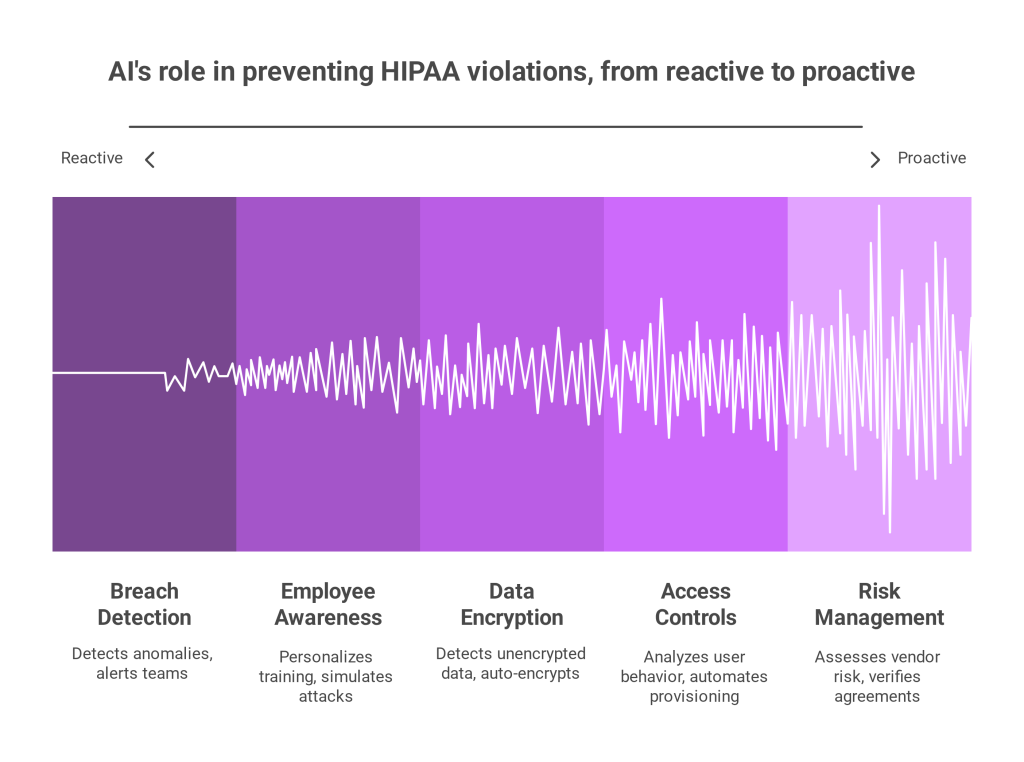The foundation of healthcare security of information in the US is the Health Insurance Portability and Accountability Act (HIPAA). It sets rules for the handling of protected health information (PHI) by insurers, medical practitioners, and their business partners. But keeping up with the ever-increasing complexity of modern technology is no easy feat. Numerous firms continue to make mistakes that lead to common HIPAA violations, endangering the confidentiality of patients, facing legal repercussions, and harming their credibility.
Thankfully, the approach to compliance is evolving due to artificial intelligence (AI). Healthcare organizations can proactively fix problems earlier they result in breaches by utilizing AI to comply with common HIPAA violations. We’ll look at five of the most frequent HIPAA infractions in this post and demonstrate how AI can help you stay clear of these offenses before investigators or hackers discover them.
The Landscape of HIPAA Compliance
HIPAA is not just about paperwork; it’s about accountability, transparency, and data security. The key components include:
- The Privacy Rule, governing access and disclosure of PHI
- The Security Rule, outlining safeguards for electronic PHI
- The Breach Notification Rule, requires notification after data breaches
- The Enforcement Rule, detailing penalties and procedures for non compliance

Violating any of these can lead to serious consequences. And in today’s digital age, breaches often happen without immediate detection, making proactive protection more important than ever.
This is where HIPAA compliance with AI becomes transformative. From real time monitoring to intelligent risk analysis, AI technologies with Sahl are built to reduce manual burden and enhance audit readiness.
1. Lack of Access Controls
The Violation
One of the most common HIPAA violations is the failure to enforce proper access controls. When unauthorized employees can access PHI, even unintentionally, it puts the organization at risk.
Examples include:
- Shared login credentials
- Inadequate role based access restrictions
- Unmonitored access to sensitive systems
How AI Prevents It
AI-powered access control tools continuously analyze user behavior. Machine learning algorithms have the ability to identify or completely prohibit data access attempts made by individuals who are not in their regular roles or at dangerous periods. It is practically difficult for illegal access to go undetected thanks to these services ability to evolve and gain insight from trends.
AI can also reduce human mistakes that could result in noncompliance by automating account provisioning and disconnecting according to roles and employment status. Businesses can regulate restricted login methods with little managerial effort thanks to following HIPAA regulations with AI.
HIPAA compliance with AI enables organizations to enforce least privilege access models with minimal administrative effort.
2. Unencrypted or Improperly Stored Data
The Violation
Failing to encrypt PHI, whether in transit or at rest, is another major HIPAA pitfall to avoid. Storing unprotected files on local drives, cloud platforms without adequate security, or unsecured servers creates an open door for data theft.
How AI Prevents It
AI can automatically detect when PHI is stored in unapproved or vulnerable locations. By scanning cloud storage, email servers, and even connected devices, AI solutions alert compliance officers to unencrypted data that violates policy.
More advanced systems can also auto encrypt data upon detection, ensuring that storage meets HIPAA standards without waiting for human intervention.
This is one of the most effective methods of preventing HIPAA breaches with AI, ensuring data remains protected throughout its lifecycle.
3. Insufficient Employee Training and Awareness
The Violation
Even the best technical safeguards can be undone by human error. Clicking on phishing emails, misplacing devices, or discussing patient information in public areas are all forms of non compliance.
According to HHS data, a significant portion of common HIPAA violations are traced back to employees, not hackers.
How AI Prevents It
AI doesn’t just protect systems; it educates users too. AI-powered training platforms personalize learning modules based on employee roles, past performance, and recent threats.
For instance, if phishing is on the rise, the system will automatically adjust its training focus to address it. It can even simulate real life attacks to test staff readiness and identify weaknesses before a real incident occurs.
By using adaptive learning models, organizations not only ensure ongoing education but also document training completion, a key requirement for audits.
This proactive strategy highlights exactly how AI helps with HIPAA compliance by integrating smart learning into daily workflows.
4. Delayed Breach Detection and Response
The Violation
HIPAA requires that data breaches be reported within 60 days of discovery. But in many cases, breaches go undetected for months, causing prolonged exposure and escalating fines.
Slow detection and response time is one of the most financially damaging common HIPAA violations.
How AI Prevents It
AI is quite good at detecting anomalies. Artificial intelligence (AI) systems can spot anomalous activity, such as a huge transfer of data, login credentials from an odd place, or forbidden gadget accessibility, in a matter of seconds by continuously tracking systems and user patterns.
AI may immediately alert the appropriate teams, start automated lockdowns, and save digital evidence for further analysis when dangers are identified. Two crucial compliance indicators, mean time to detection (MTTD) and mean time to response (MTTR), are significantly decreased as a result.
Reducing the range of sensitivity is key to avoiding HIPAA breaches with AI, ensuring that damage is promptly limited even in the event of an occurrence.
5. Inadequate Third Party Risk Management
The Violation
Business associates and third party vendors often process or access PHI. If these partners fail to meet HIPAA standards, your organization is still liable.
A lack of due diligence or failure to maintain Business Associate Agreements (BAAs) is a top contributor to common HIPAA violations.
How AI Prevents It
Modern AI platforms can assess and monitor third party risk continuously. Instead of performing static, annual risk reviews, AI tools analyze vendor behavior, compliance history, and system interactions in real time.
They can automatically flag vendors who pose an elevated risk or whose security posture declines over time. Smart contract analysis tools can even verify whether BAAs are up to date, complete, and aligned with regulatory standards.
This automation provides consistent oversight and documentation, key to demonstrating HIPAA compliance with AI during an audit or investigation.

The Real World Impact of AI-Driven HIPAA Compliance
Businesses that use AI are getting a competitive edge rather than only being compliant. Security teams may concentrate on planning for the future rather than manual firefighting by managing periodic reviews, implementation of policies, and learning.
Moreover, AI systems retain detailed logs of actions, alerts, and mitigation steps, which can be used as defensible proof during investigations. This kind of real time, data driven compliance is a game changer that ensures readiness not just for HIPAA but for a future where regulations continue to evolve.
In short, HIPAA compliance with AI doesn’t just reduce risk; it enhances agility, transparency, and trust across the healthcare ecosystem.
Conclusion
The initial phase in preventing HIPAA infractions is being aware of the most frequent ones. True compliance, however, necessitates action, automation, and constant attention to detail; it expands far beyond knowledge. By incorporating AI within your safety system, you’re protecting your company against both known and unknown threats in addition to complying with rules.
AI can turn HIPAA from a nuisance into a competitive edge in a number of areas, including managing suppliers, training employees, threat identification, and accessibility restrictions. In the current healthcare climate, using AI for safeguarding HIPAA violations is more than an option, it is now essential.



